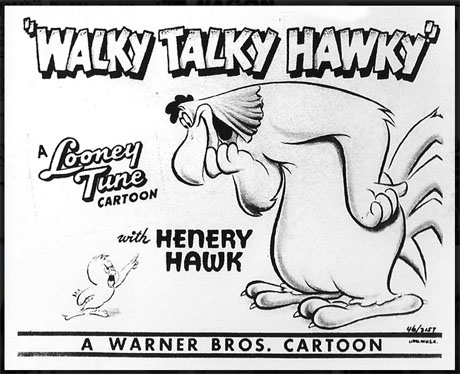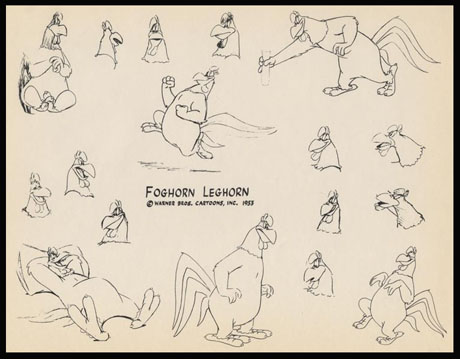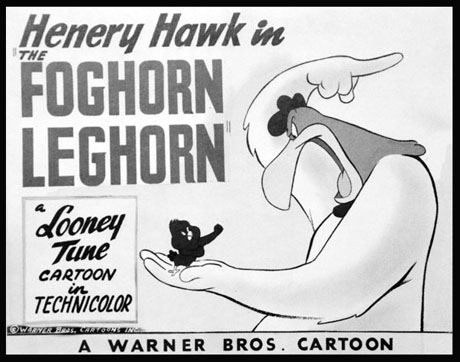
In his most famous quote, actor Konstantin Stanislavski once said: “There are no small parts, only small actors.” As hard as it is to imagine, this is true of none other than Foghorn Leghorn. The loud, overbearing, blustery rooster made his first appearance seventy-five years ago this month in the 1946 Warner Bros. Cartoon short, Walky Talky Hawky. He wasn’t the star of that short, that was Henery Hawk, but Foghorn’s very animated appearance made such an indelible impact on audiences, he would soon be the standout star.

Foghorn Leghorn’s personality seemed to be based on a popular radio character of the time, “Senator Claghorn of Bighorn,” played by actor Kenny Delmar on The Fred Allen Show. The voices of both characters are almost identical, particularly certain vocal traits – “I say,” followed by repeated dialogue, as well as “Pay attention when I’m talking to you, son” – but there were also other influences for the character.
Legendary director Robert McKimson, who directed Walky Talky Hawky and first brought Foghorn to the screen, noted another character, the Sherriff, on the show Blue Monday Jamboree was also an influence. Vocal genius Mel Blanc, who provided Foghorn’s voice, actually credited a character from an old vaudeville show he had seen as a young boy.
These inspirations came together to form one of the most bombastic characters in the Warner Bros. canon.

Foghorn’s first cartoon short, Walky Talky Hawky, (released on August 31, 1946) follows a plot in which young Henery Hawk finds out that he is a chicken hawk and heads off to find a chicken (which he has never seen before).
Meanwhile, in the barnyard, Foghorn faces off against the Barnyard Dawg, his recurring foe. Their “back-and-forth” follows what would become a familiar pattern: Foghorn hits the Dawg with a paddle, angering the dog, who then chases after Foghorn. However, the poor Dawg is attached to the doghouse by a leash, which eventually chokes him, “yanking” him backward.
Henery enters the barnyard, meeting Foghorn, who convinces the little hawk that Barnyard Dawg is a chicken, luring Henery into his tortuous plans for the Dawg. However, the Dawg gets loose from his doghouse, and a free-for-all ensues between him and Foghorn, which then spills over into a stable and involves a horse.
The short ends with Henery capturing all three- dog, rooster, and horse – carrying them away and mimicking Foghorn, as he says, “One of these things, I say, one of these things has got the be a chicken!”

This would become a recurring story line for many of Foghorn’s future shorts.
There were some variations: Sylvester joined the proceedings in 1947’s Crowing Pains; in 1953’s Of Rice and Hen, Foghorn meets Miss Prissy, the skinny, spinster chicken who wants to wed the rooster, and in Little Boy Boo, Foghorn comes up against Miss Prissy’s son, a petite chick named Egghead, jr., bookish with an oversized head, he was a wonder of character design.
In each of these shorts, Foghorn would display what would become his expected, usual character traits, such as singing “Camptown Races” and his unique speech patterns: “That’s a joke, boy! You missed it! It went right past you.” Or “Look at me when I’m talking, son.”
This all came together as one of the most memorable creations to emerge from Warner Bros. And, seventy-five years later, knowing what we all know about Foghorn Leghorn, he’d be the first to tell us the same.
- An Eye for A Classic: The 60th Anniversary of “Mr. Magoo’s Christmas Carol” - December 22, 2022
- A Very Merry Mickey: The 70th Anniversary of “Pluto’s Christmas Tree” - December 19, 2022
- A Fine French Feline Film: The 60th Anniversary of “Gay Pur-ee” - December 12, 2022


 August 20th, 2021
August 20th, 2021  Michael Lyons
Michael Lyons  Posted in
Posted in  Tags:
Tags: 






